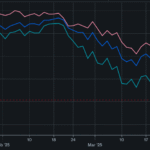As we move through 2025, the United States economy continues to show signs of resilience and transformation despite ongoing global uncertainties. While inflationary pressures, geopolitical tensions, and labor market fluctuations remain, several key sectors in the U.S. have not only weathered the storm but emerged stronger, more dynamic, and filled with opportunities.
In this edition of Growth Watch, we examine the top-performing sectors in the U.S. economy in 2025, highlighting what’s driving their growth, where investors should pay attention, and how innovation, policy, and consumer behavior are shaping the landscape.
1. Technology Sector: AI and Cloud Continue to Dominate
The tech sector remains at the forefront of economic growth, with Artificial Intelligence (AI) and Cloud Computing leading the charge. In 2025, the adoption of AI is no longer limited to big tech firms—it’s being integrated into healthcare, manufacturing, finance, and even agriculture.
Key Drivers:
- AI Integration: Businesses are automating customer service, data analysis, and supply chain functions through generative and predictive AI tools.
- Cloud Expansion: Enterprises are shifting from legacy infrastructure to cloud-native models for scalability and agility.
- Cybersecurity Demand: With growing cyber threats, cybersecurity startups are experiencing unprecedented growth.
Notable Companies:
- Nvidia, Microsoft, and Palantir continue to thrive.
- Startups in AI-model training and cloud optimization tools are attracting significant VC funding.
2. Clean Energy & Sustainability: The Green Boom Accelerates
Environmental, Social, and Governance (ESG) investing is no longer a trend—it’s a priority. With the U.S. government doubling down on green infrastructure through tax credits and the Inflation Reduction Act incentives, clean energy companies are booming.
Key Drivers:
- Solar & Wind Energy Projects: Massive investments in solar and wind farms, especially in Texas, California, and the Midwest.
- Electric Vehicles (EVs): Federal and state-level incentives are making EVs more accessible, boosting demand.
- Battery Storage & Hydrogen: Technologies enabling longer energy storage and hydrogen production are seeing high growth.
Emerging Areas:
- Green hydrogen startups and lithium recycling companies are scaling fast.
- Utility companies transitioning to renewable energy portfolios.
3. Healthcare & Biotech: Innovation, AI, and Preventive Medicine
The U.S. healthcare sector is undergoing a digital transformation. In 2025, AI-powered diagnostics, wearable health tech, and personalized medicine are driving significant gains in productivity, accuracy, and cost efficiency.
Key Drivers:
- Telehealth Growth: Remote consultations are now integrated into standard healthcare systems.
- Biotech Breakthroughs: mRNA technology has paved the way for fast-tracked vaccines and therapies for chronic illnesses.
- Health Data Analytics: Predictive analytics for early disease detection is saving lives and money.
Investment Hotspots:
- AI diagnostic platforms (e.g., Tempus, PathAI)
- Genomic research companies like Illumina
- Startups offering decentralized clinical trials
4. Financial Technology (Fintech): Banking Reimagined
Fintech is disrupting traditional financial institutions by offering faster, cheaper, and more personalized financial services. In 2025, this sector is growing rapidly thanks to increasing digital adoption and embedded finance across apps and platforms.
Key Trends:
- Decentralized Finance (DeFi): While regulated, blockchain-driven platforms are gaining trust among retail and institutional users.
- Buy Now, Pay Later (BNPL): Despite scrutiny, BNPL remains popular among Gen Z and millennials.
- AI in Banking: Automated wealth management and credit scoring systems are improving accessibility and risk management.
Growth Stories:
- Challenger banks like Chime and SoFi are scaling new services.
- Peer-to-peer lending and insurance tech platforms are seeing user growth.
5. Advanced Manufacturing & Industrial Automation
With reshoring of supply chains and increasing investment in infrastructure, the U.S. manufacturing sector is undergoing a modern renaissance. Advanced robotics, additive manufacturing (3D printing), and AI-powered logistics are leading the way.
Key Drivers:
- Supply Chain Localization: Companies are moving production back to the U.S. due to global instability.
- Smart Factories: Use of IoT and AI for real-time monitoring and predictive maintenance.
- Defense & Aerospace Investment: Government contracts for defense systems, satellites, and space missions.
Notable Companies:
- Lockheed Martin, General Electric, and upstart robotics firms are capitalizing on smart automation.
6. E-Commerce & Consumer Technology
Though e-commerce growth slowed post-pandemic, 2025 has seen a resurgence—especially in niche, high-value areas such as luxury DTC brands, sustainable goods, and AI-enhanced shopping experiences.
What’s Driving Growth:
- Omnichannel Shopping: Integration of physical stores with digital platforms.
- AI-Personalized Marketing: Higher conversion rates through smarter customer engagement.
- Subscription-Based Models: High customer retention for brands offering recurring services.
Watch This Space:
- Augmented reality (AR) in retail
- Social commerce platforms like TikTok Shop in the U.S.
7. Real Estate & PropTech: Innovation Amidst Caution
While commercial real estate faces challenges due to hybrid work, residential housing—especially in emerging metros—is witnessing significant appreciation. PropTech is modernizing how people buy, rent, and invest in real estate.
Key Developments:
- Smart Homes: Integration of IoT devices for energy efficiency and security.
- Fractional Real Estate Investing: Platforms enabling retail investors to invest in real estate portfolios.
- Sunbelt States Boom: Cities like Austin, Phoenix, and Tampa are driving residential demand.
8. Logistics & Supply Chain Technology
Thanks to e-commerce, EV trucks, and drone deliveries, logistics has evolved from a backend operation to a critical pillar of modern commerce.
Growth Factors:
- AI Route Optimization: Reducing last-mile delivery costs.
- Autonomous Warehousing: Robots and smart systems managing inventory.
- Green Logistics: Low-emission fleets and electric cargo transport.
High Performers:
- Companies like Flexport and Gatik are transforming supply chain efficiency.
9. EdTech: Personalized Learning at Scale
Remote learning may have started as a pandemic necessity, but in 2025, EdTech has matured into an adaptable, hybrid solution integrated into mainstream education systems.
What’s Working:
- Adaptive Learning Platforms: Customized coursework based on learner performance.
- AI Tutors & Chatbots: 24/7 support for learners at all levels.
- Corporate Upskilling Platforms: Enterprises investing in internal learning systems.
10. Digital Media & Entertainment
Streaming, gaming, and the creator economy continue to fuel growth in digital entertainment. In 2025, immersive technologies like AR/VR and interactive storytelling are reshaping how people consume content.
Key Growth Areas:
- Gaming-as-a-Service (GaaS): Monthly subscription platforms.
- Short-form Video: Monetization tools are making content creation a career.
- Virtual Events & Concerts: New monetization models for artists and entertainers.
Summary Table: Top Sectors by Growth Potential in 2025
| Sector | Key Trend | Growth Outlook |
|---|---|---|
| Technology (AI/Cloud) | AI adoption, cloud migration | High |
| Clean Energy | Green incentives, EV expansion | High |
| Healthcare & Biotech | AI diagnostics, personalized medicine | High |
| Fintech | DeFi, digital banking, AI automation | High |
| Advanced Manufacturing | Reshoring, smart factories | Strong |
| E-commerce & Consumer Tech | Personalization, social commerce | Strong |
| PropTech & Real Estate | Smart homes, fractional investing | Mixed |
| Logistics & Supply Chain | AI, automation, green logistics | Strong |
| EdTech | Adaptive learning, corporate upskilling | Growing |
| Digital Media & Gaming | Streaming, AR/VR, creator economy | Growing |
Final Thoughts: Where Should Investors & Entrepreneurs Focus?
2025 offers a dynamic environment for growth, especially in sectors where technology meets necessity. Whether it’s clean energy’s answer to climate change, fintech’s push for financial inclusion, or AI’s revolution of every major industry—opportunity abounds for those who adapt and invest wisely.
Investors should keep a close eye on mid-cap and high-growth tech stocks, clean energy ETFs, and emerging market leaders in healthcare and manufacturing. Entrepreneurs should consider entering sectors where automation, personalization, or decentralization is still underutilized.


